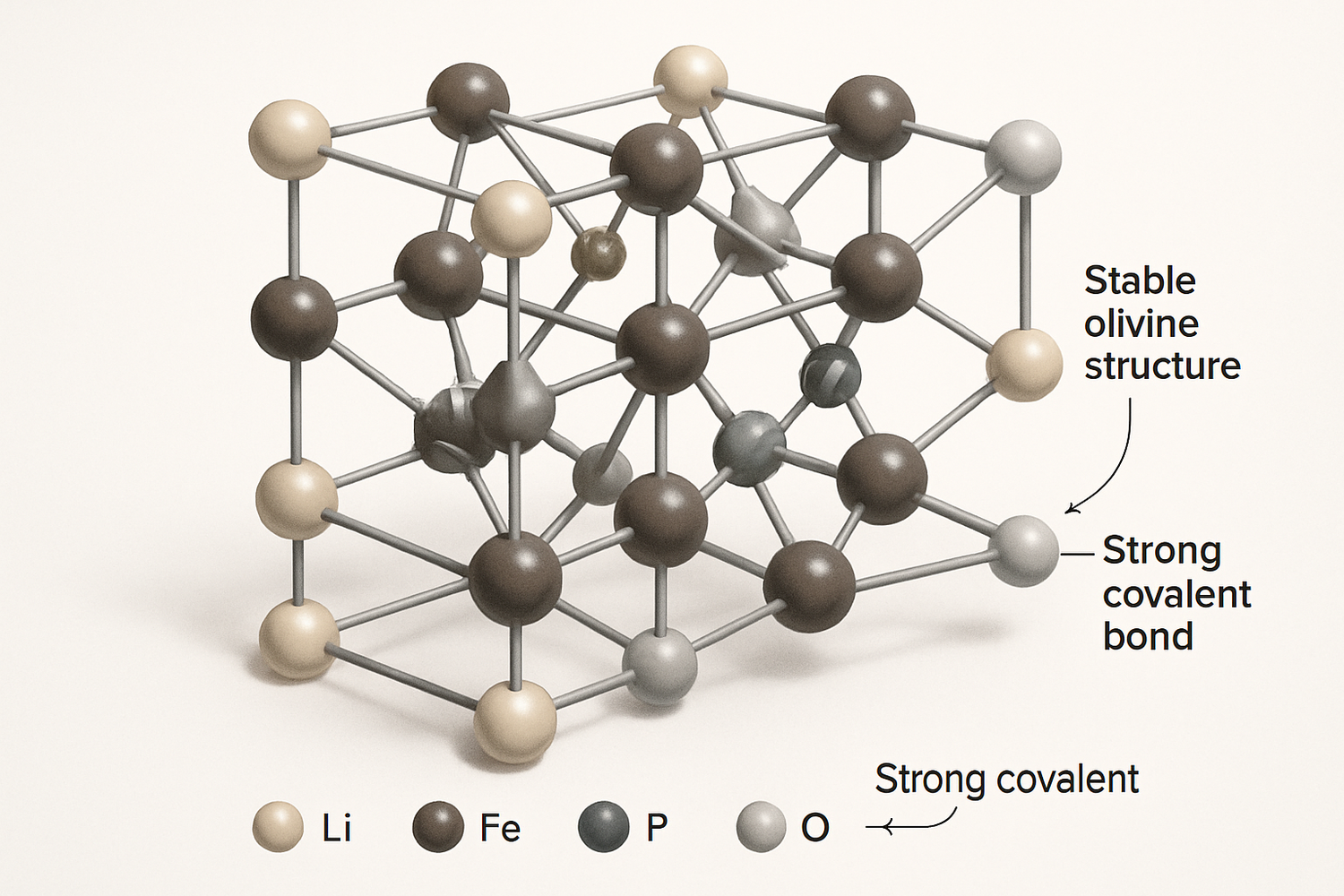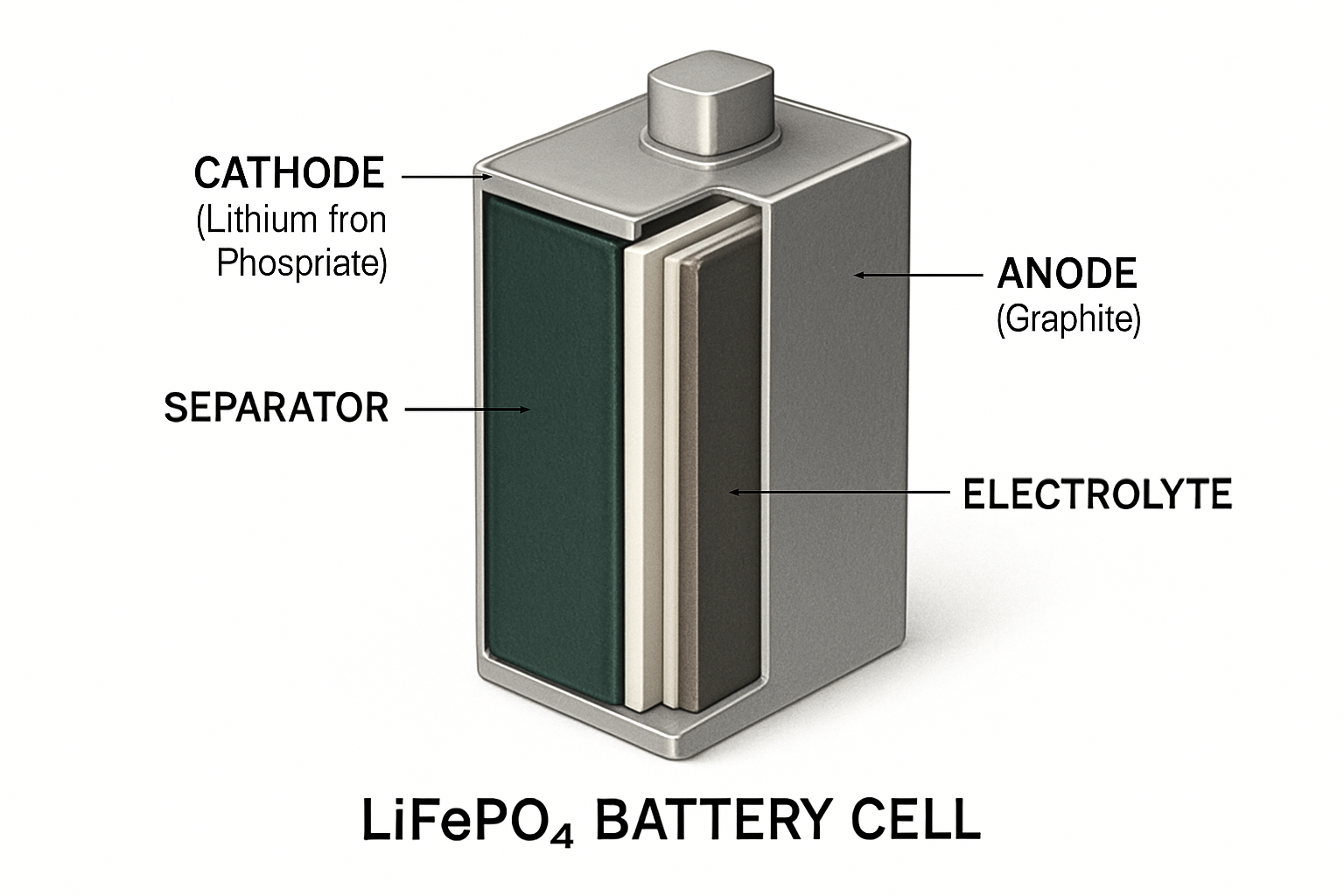As solar and off-grid energy solutions become more common, lithium iron phosphate (LiFePO4) batteries are a frequent choice for energy storage. With their rising popularity, a lot of information—and misinformation—has appeared, especially concerning safety. Many people group all 'lithium' batteries together, leading to confusion and unnecessary concern. This clears up the myths and presents the facts about LiFePO4 battery safety, helping you make a confident and informed decision for your energy needs.
Understanding LiFePO4 Chemistry: The Foundation of Safety
The safety profile of any battery begins with its fundamental chemistry. LiFePO4 batteries are chemically different from the lithium-ion batteries found in many consumer electronics, and this difference is key to their stability.
What Makes LiFePO4 Different?
The core of LiFePO4's stability lies in its cathode material, lithium iron phosphate. The atoms in this material are held together by extremely strong covalent bonds within a crystal structure known as an olivine structure. According to research referenced by the U.S. Department of Energy, the bond between the phosphorus and oxygen atoms in the phosphate group is significantly stronger than the metal-oxygen bonds in other chemistries like Nickel Manganese Cobalt (NMC). This robust structure resists breaking down under stress, such as overcharging or high temperatures.
Exceptional Thermal Stability
A major concern with any high-energy battery is 'thermal runaway'. This is a chain reaction where an increase in temperature causes the system to release more energy, which in turn increases the temperature further, potentially leading to fire. LiFePO4 chemistry is far less prone to this. Its thermal runaway threshold is around 270°C (518°F), significantly higher than the approximate 210°C (410°F) for NMC batteries. A critical reason for this is that the LiFePO4 cathode does not release oxygen when it breaks down, a key ingredient that fuels fires in other lithium chemistries.
Myth-Busting: Addressing Common LiFePO4 Concerns
Misconceptions about lithium batteries often stem from news reports of fires in phones, laptops, or vapes. It is important to distinguish LiFePO4 technology from the chemistries used in those devices.
Myth 1: 'All Lithium Batteries Are Serious Fire Hazards'
This is the most pervasive myth. The incidents that create headlines typically involve batteries with high energy density but lower thermal stability, like lithium cobalt oxide (LCO) or NMC. LiFePO4 was specifically chosen for applications like home battery storage systems and off-grid solar because safety and longevity are prioritized over packing the absolute maximum energy into the smallest space. The International Energy Agency (IEA) notes the rapid growth of battery storage, a trend supported by increasingly safe and reliable technologies. Furthermore, regulations and safety standards are continuously improving. The U.S. Environmental Protection Agency (EPA) has released comprehensive guidance to help communities plan for the safe installation and operation of Battery Energy Storage Systems (BESS), reflecting a commitment to minimizing risks.
Myth 2: 'LiFePO4 Batteries Will Explode if Punctured'
While no battery is indestructible, the response of a LiFePO4 battery to physical damage is remarkably stable. In puncture or crush tests, a LiFePO4 cell is much less likely to experience a violent reaction. It may release smoke or become hot, but the risk of fire or explosion is dramatically lower compared to its cobalt-based counterparts. This resilience is a primary reason they are favored for use in homes, RVs, and boats where physical security is paramount.
Myth 3: 'Overcharging a LiFePO4 Battery Is a Disaster Waiting to Happen'
Any battery can be damaged by improper charging, but modern LiFePO4 batteries have a powerful safeguard: the Battery Management System (BMS). This integrated electronic system is the brain of the battery pack. It provides protection against over-voltage (overcharging), under-voltage (over-discharging), short circuits, and excessive temperatures. A quality BMS will automatically stop the charging process once the cells are full, making a catastrophic overcharge event nearly impossible under normal conditions.
The Critical Role of the Battery Management System (BMS)
The BMS is more than just a simple on/off switch. It is a sophisticated component that ensures both the safety and the longevity of the battery pack.
Beyond Basic Protection
A high-quality BMS actively manages the health of the battery pack. Its functions include:
- Cell Balancing: It ensures all individual cells within the battery pack maintain an equal state of charge. This prevents certain cells from being over-stressed, which improves the overall lifespan and performance of the pack.
- Temperature Monitoring: The BMS constantly monitors temperature and can prevent charging or discharging in extreme conditions, such as attempting to charge a 12v 100ah lifepo4 lithium battery below freezing, which can cause permanent damage.
- State of Health (SoH) and State of Charge (SoC) Calculation: It provides accurate data on the battery's condition and how much energy is available.
Why a Quality BMS is Non-Negotiable
The effectiveness of a lithium battery storage solution is directly tied to its BMS. A well-managed battery not only operates safely but also delivers more consistent power and a longer service life. This efficiency is a crucial factor in evaluating overall solar storage performance. When selecting a deep cycle lithium battery, the quality and features of its BMS should be a primary consideration.
Practical Safety and Best Practices
While LiFePO4 technology is inherently safe, following proper procedures ensures maximum security and longevity for your energy storage solutions.
Proper Installation and Handling
Correct installation is the first step to a safe system. Always ensure good ventilation around the battery to dissipate heat. Use the correct gauge of cables to handle the electrical current and ensure all terminal connections are tight. A loose connection can generate heat and reduce efficiency. Protect the battery from direct impact or puncture risks.
Charging and Discharging Guidelines
Always use a charger specifically designed for the LiFePO4 chemistry. These chargers have the correct voltage and charging algorithms to work with the BMS. Avoid operating the battery outside its recommended temperature range, typically from -20°C to 60°C (-4°F to 140°F) for discharging. Following manufacturer guidelines is a simple yet effective way to ensure safety, a point emphasized by organizations like OSHA in their recommendations for handling lithium-ion batteries.
A Secure Foundation for Energy Independence
The evidence is clear: LiFePO4 batteries offer an exceptionally safe and reliable method for energy storage. Their stable chemistry, combined with the oversight of an advanced Battery Management System, provides multiple layers of protection. By moving past the generalized myths surrounding lithium batteries and focusing on the specific, stable characteristics of lithium iron phosphate, you can confidently build a dependable and secure energy system for your home, business, or mobile application.
Frequently Asked Questions
Are LiFePO4 batteries safer than lead-acid batteries?
In many practical ways, yes. LiFePO4 batteries are sealed units that do not produce flammable hydrogen gas during charging, unlike flooded lead-acid batteries. They also eliminate the risk of acid spills and corrosion. The inclusion of an integrated BMS provides active protection against electrical faults, a feature absent in traditional lead-acid batteries.
Can a LiFePO4 battery be used in any application?
LiFePO4 batteries excel in deep-cycle applications where they are regularly charged and discharged, such as in a solar energy storage system, for RV house power, or in marine applications. While they can be designed for high-current engine starting, their primary strength is in providing sustained, long-term power.
What safety certifications should I look for in a LiFePO4 battery?
Look for batteries that have been tested and certified by nationally recognized testing labs. Key standards include UL 1973 for stationary energy storage systems, UL 1642 for the cells themselves, and UN 38.3 for transportation safety. These certifications indicate that the battery has passed a rigorous set of tests for electrical and mechanical safety.





Leave a comment
All comments are moderated before being published.
This site is protected by hCaptcha and the hCaptcha Privacy Policy and Terms of Service apply.